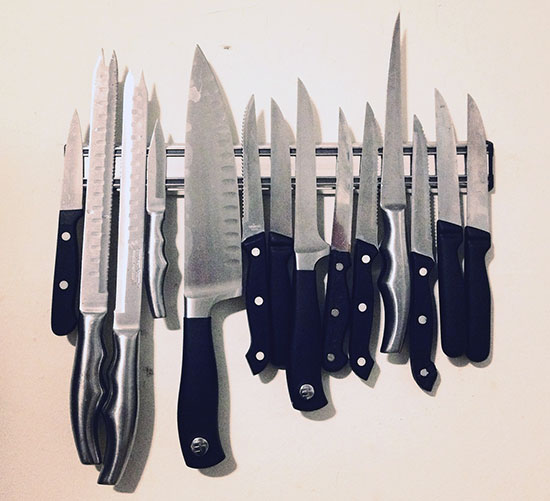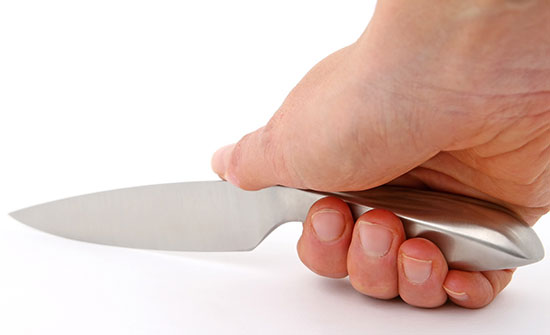Buying knives can be a breeze … or an exercise in confusion. What is a honesuki knife and what do I use it for? Is there really difference between a meat and a vegetable cleaver? What is the best way to store my knives. Well, in this quick guide, I’ll provide you with some basics that will help you understand what you’re looking at, using and buying when in the knife section of your cooking goods store.

Source: Pixabay
Glossary for Buying Knives
When buying knifes, you need to know what your shopping options are. This glossary will help.
Boning knife – This knife is easy to recognized because of its narrow blade, which makes it perfect or carving around bones in both meat and poultry.
Chef’s knife – A basic, all-purpose knife used for chopping, slicing, dicing and mincing.
Honesuki knife – This Japanese boning knife has a triangular blade, which makes it easy to work around the bones and joints of poultry.
Meat cleaver – With its large blade, this knife handles big carving jobs. With a single downward stroke, a meat cleaver can slice through most cuts of meat.
Nakiri knife – A Japanese knife used for chopping vegetables.
Paring knife – This is a small, precise knife used for trimming and slicing fruits, vegetables and herbs.
Santoku knife – Ideal for mincing, dicing and slicing, this multipurpose knife is a hybrid of a chef’s knife and a cleaver.
Serrated knife – This is a long knife with a saw-like edge used to cutting loaves of bread without squishing the crust. For this reason, it is sometimes called a bread knife.
Slicing/carving knife – A thin-bladed knife used for cutting meat, poultry and fish.
Steak knife – A small, serrated knife used to cut through heartier meats that your traditional table knife won’t.
Tomato knife – This knife keeps tomato skins from tearing because of its very thin, serrated edge. You can also use this with citrus fruits.
Utility knife – Like a chef’s knife, but smaller. Used to cutting sandwiches, slicing meat and pretty much anything else that doesn’t call for a chef’s knife.
Vegetable cleaver – Like the meat cleaver, a vegetable cleaver has a wide blade. However, the blade is finer for it is meant to chop produce, which requires a little more finesse.
Choosing Your Knives
You will use your knives pretty much every day, so you want to make sure you are comfortable with them and that they will perform well in your kitchen. Therefore you’ll want to interact with a knife before investing in it. Here are some tips to help you choose the right knives for you.
- Hold different knives. How do they feel in your hand? Is it solid and secure in your grip? Is it balanced?
- Do you want your knives to match? You can buy knives individually or in a set. Beginner cooks are usually well served by the sets, but the more you use a knife, the more likely you should pick it out individually.
- Decide what material you want your knives to be made of. Stainless steel are easy to maintain and durable. So most people go with them. However you have other options:
- Ceramic – rust-proof, impervious to acids, prone to chipping, don’t need sharpening as often, must be professionally sharpened, not as sharp as metal knives
- Carbon steel – sharpest knives of all, easiest to keep sharp, must be cleaned and dried immediately after use
- How do you cook? Do you cook a lot of meat? Then you’ll need to buy knives meant for meat. Do you bake your own bread? Make sure you have a bread knife. Make sure that you buy knives you’ll actually use.

Source: Pixabay
Essential Knives
When buying knives, you’ll want to make sure that you have on hand the four most commonly used knives. For most people, these four are all they need: Chef’s knife, utility knife, serrated knife and paring knife.
Caring for Your Knives
You’ve taken care to buy the right knives for your home, now you need to care for them so don’t have to go back to buying knives again!
First, you need to store them so that they are dulled and you don’t cut yourself accessing them. If you bought a set that comes with a block, you’re set. You can also buy blocks separately. A magnetic strip attached to the wall or your refrigerator is another way to keep your knives handy. Don’t keep them loose in drawer … they’ll dull while jostling against each other and you could get cut when reaching in to get one.
After each use, you’ll need to clean your knives. Do this by hand … dishwashers will dull and possibly damage your knives. Simply clean with warm water and soap then dry. Easy!
Alas, knives dull, so you’ll to to sharpen them occasionally. You have several options:
- A handheld steel dowel much like a metal file.
- A knife sharpener that you run your knife through.
- Professionals at your local kitchen retailer.
Armed with the tips and information in this post, you can be quite successful the next time you go buying knives.

